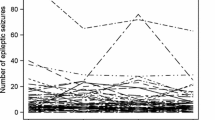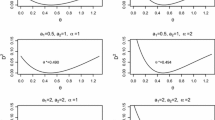Abstract
A parametric robust approach for analyzing correlated count data is introduced. This method enables one to construct an asymptotically valid likelihood for the regression parameter when knowledge about the joint distribution for data is scarce or not available. We use simulations and real data analysis to demonstrate the merit of the proposed robust likelihood method.




Similar content being viewed by others
References
Alfo M, Trovato G (2004) Semiparametric mixture models for multivariate count data, with application. Econom J 7:426–454
Bartlett MS (1953) Approximate confidence intervals. Biometrika 40:12–19
Berkhout P, Plug E (2004) A bivariate Poisson count data model using conditional probabilities. Stat Neerl 58:349–364
Cameron AC, Li T, Trivedi K, Zimmer DM (2004) Modelling the differences in counted outcomes using bivariate copula models with application to mismeasured counts. Econom J 7:566–584
Cox DR, Hinkley DV (1986) Theoretical statistics. Chapman and Hall, New York
Cox DR, Reid N (1987) Parameter orthogonality and approximate conditional inference. J R Stat Soc B 49:1–39
Diggle PJ, Liang KY, Zeger SL (1994) Analysis of longitudinal data. Oxford University Press, Oxford
Fiocco M, Putter H, Van Houwelingen JC (2009) A new serially correlated gamma-frailty process for longitudinal count data. Biostatistics 10:245–257
Gurmu S, Elder J (2007) A simple bivariate count data regression model. Econ Bull 3:1–10
Hadgu A, Koch G (1999) Application of generalized estimating equations to a dental randomized clinical trial. J Biopharm Stat 9:161–178
Hauck WW, Donner A (1977) Wald’s test as applied to hypotheses in logit analysis. J Am Stat Assoc 72:851–853
Huber PJ (1981) Robust statistics. Wiley, New York
Kauermann G, Carroll RJ (2001) A note on the efficiency of sandwich covariance matrix estimation. J Am Stat Assoc 96:1387–1396
Liang KY, Zeger SL (1986) Longitudinal data analysis using generalized linear models. Biometrika 73:13–22
Maronna R, Martin D, Yohai V (2006) Robust statistics: theory and methods. Wiley, West Sussex
McCullagh P (1983) Quasi-likelihood functions. Ann Stat 11:59–67
R Core Team (2014) R: A language and environment for statistical computing. R Foundation for Statistical Computing, Vienna, Austria. http://www.R-project.org/
Royall RM (2000) On the probability of observing misleading statistical evidence (with discussion). J Am Stat Assoc 95:760–780
Royall RM, Tsou TS (2003) Interpreting statistical evidence using imperfect models: robust adjusted likelihood functions. J R Stat Soc Ser B 65:391–404
Solis-Trapala IL, Farewell VT (2005) Regression analysis of overdispersed correlated count data with subject specific covariates. Stat Med 24:2557–2575
Stafford JE (1996) A robust adjustment of the profile likelihood. Ann Stat 24:336–352
Thall PF, Vail SC (1990) Some covariance models for longitudinal count data with overdispersion. Biometrics 46:57–671
Turesky S, Gilmore ND, Glickman J (1970) Reduced plaque formation by the chloromethyl analogue of Victamine. J Periodontol 41:41
Venables WN, Ripley BD (2002) Modern applied statistics with S, 4th edn. Springer, New York
White H (1982) Maximum likelihood estimation of misspecified models. Econometrica 50:1–25
Acknowledgments
This work is supported by Grant NSC 102-2118-M-008-001-MY2 of National Science Council, Taiwan, ROC.
Author information
Authors and Affiliations
Corresponding author
Appendix: The I and V terms
Appendix: The I and V terms
The two matrices I and V required to calculate the amendment that robustifies the naïve likelihood function are simply the Fisher information matrix and the variance matrix of the score functions. Their derivation is straightforward and routine. Following the definitions, one can show that the matrix I consists of entries
\(r,s=0,\ldots ,p-1,\) and

The components of the matrix V are
Rights and permissions
About this article
Cite this article
Tsou, TS. Robust likelihood inference for multivariate correlated count data. Comput Stat 31, 845–857 (2016). https://doi.org/10.1007/s00180-015-0589-3
Received:
Accepted:
Published:
Issue Date:
DOI: https://doi.org/10.1007/s00180-015-0589-3




